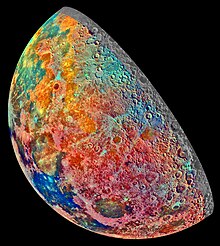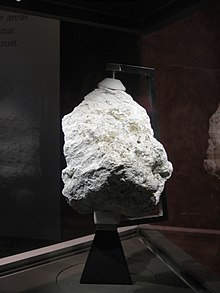
Back الموارد القمرية Arabic Recursos lunares Spanish منابع ماه Persian चंद्रमा पर संसाधन Hindi A Hold erőforrásai Hungarian 月球资源 Chinese


The Moon bears substantial natural resources which could be exploited in the future.[1][2] Potential lunar resources may encompass processable materials such as volatiles and minerals, along with geologic structures such as lava tubes that, together, might enable lunar habitation. The use of resources on the Moon may provide a means of reducing the cost and risk of lunar exploration and beyond.[3][4][5]
Insights about lunar resources gained from orbit and sample-return missions have greatly enhanced the understanding of the potential for in situ resource utilization (ISRU) at the Moon, but that knowledge is not yet sufficient to fully justify the commitment of large financial resources to implement an ISRU-based campaign.[6] The determination of resource availability will drive the selection of sites for human settlement.[7][8]
- ^ Crawford, Ian (2015). "Lunar Resources: A Review". Progress in Physical Geography. 39 (2): 137–167. arXiv:1410.6865. Bibcode:2015PrPhG..39..137C. doi:10.1177/0309133314567585. S2CID 54904229.
- ^ Yuhao Lu and Ramaa G. Reddy. Extraction of Metals and Oxygen from Lunar Soil. Archived 2021-11-23 at the Wayback Machine Department of Metallurgical and Materials Engineering; The University of Alabama, Tuscaloosa, Alabama. USA. 9 January 2009.
- ^ Paravano, Alessandro; Rosseau, Brendan; Locatelli, Giorgio; Weinzierl, Mathew; Trucco, Paolo (2025-03-01). "Toward the LEO economy: A value assessment of commercial space stations for space and non-space users". Acta Astronautica. 228: 453–473. doi:10.1016/j.actaastro.2024.11.060. ISSN 0094-5765.
- ^ M. Anand, I. A. Crawford, M. Balat-Pichelin, S. Abanades, W. van Westrenen, G. Péraudeau, R. Jaumann, W. Seboldt. "Moon and likely initial in situ resource utilization (ISRU) applications." Planetary and Space Science; volume 74; issue 1; December 2012, pp: 42—48. doi:10.1016/j.pss.2012.08.012.
- ^ Gerald B. Sanders, Micael Dule. NASA In-Situ Resource Utilization (ISRU) Capability Roadmap Final Report. Archived 2020-09-05 at the Wayback Machine. May 19, 2005.
- ^ S. A. Bailey. "Lunar Resource Prospecting". Lunar ISRU 2019: Developing a New Space Economy Through Lunar Resources and Their Utilization. July 15–17, 2019, Columbia, Maryland.
- ^ D. C. Barker. "Lunar Resources: From Finding to Making Demand." Lunar ISRU 2019: Developing a New Space Economy Through Lunar Resources and Their Utilization. July 15–17, 2019, Columbia, Maryland.
- ^ J. L. Heldmann, A. C. Colaprete, R. C. Elphic, and D. R. Andrews. "Landing Site Selection And Effects On Robotic Resource Prospecting Mission Operations." Lunar ISRU 2019: Developing a New Space Economy Through Lunar Resources and Their Utilization. July 15–17, 2019, Columbia, Maryland.